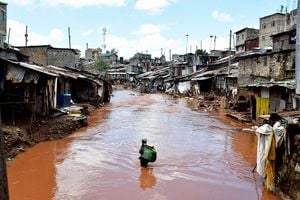Unpacking climate mitigation through an African lens

Kenya, in particular, has witnessed some of the worst weather patterns in recent years
What you need to know:
- Countries in the Horn of Africa, including Ethiopia, Kenya, and Somalia, have been repeatedly ravaged by severe droughts, leading to catastrophic food shortages, mass displacement and heightened vulnerability to diseases.
Climate mitigation is often confused with adaptation. While adaptation involves adjusting to the changing climate, mitigation focuses on reducing greenhouse gas emissions to slow down global warming. Unlike adaptation, mitigation is a proactive approach to tackle the root cause of climate change rather than merely coping with its consequences. Given the escalating frequency and intensity of climate-related disasters, the urgency for mitigation is undeniable.
Africa is on the frontline of climate change, with its populations disproportionately bearing the brunt of extreme weather events. Countries in the Horn of Africa, including Ethiopia, Kenya, and Somalia, have been repeatedly ravaged by severe droughts, leading to catastrophic food shortages, mass displacement and heightened vulnerability to diseases. Coastal nations such as Mozambique, Nigeria and Angola are grappling with the impacts of rising sea levels, including coastal erosion, flooding and the destruction of critical infrastructure.
The changing climate patterns have also contributed to a surge in climate-sensitive diseases across Africa. Countries like Kenya, Uganda and Tanzania have experienced outbreaks of dengue fever, a mosquito-borne illness that thrives in warmer temperatures and wetter conditions. The increased frequency and intensity of floods have created breeding grounds for mosquitoes, leading to the resurgence of malaria in many parts of the continent. These health crises further exacerbate the challenges faced by African populations already struggling with poverty, malnutrition and limited access to healthcare.
Mitigation strategies primarily involve transitioning to clean energy sources, improving energy efficiency and adopting sustainable land use practices. With its historical contribution to greenhouse gas emissions and substantial economic resources, the Global North has a greater capacity for implementing these strategies. Many countries have invested in renewable energy technologies such as solar and wind power and have enacted policies to reduce carbon footprints. Electric vehicles, for example, are gaining popularity in these regions as a cleaner alternative to traditional gasoline-powered cars.
However, the Global South faces distinct challenges in mitigating climate change. Developing countries often prioritise economic growth and poverty reduction, which can lead to increased emissions. Limited financial resources and technological capabilities can hinder their ability to invest in clean energy infrastructure. These countries are also disproportionately affected by climate change despite contributing relatively less to the problem. This creates a complex situation where the countries least responsible for climate change bear the brunt of its impacts.
Despite these challenges, the Global South is taking steps towards mitigation. Many countries are embracing renewable energy, particularly solar power, due to its affordability and suitability for rural areas. For instance, Kenya has made significant strides in expanding its geothermal energy capacity. There is a growing emphasis on sustainable agriculture and reforestation to sequester carbon and build resilience.
Countries with developing economies require more support to reduce their emissions and build resilience. This makes climate finance the lifeblood of mitigation efforts. Proper financing provides the necessary resources to fund the transition to clean energy, develop sustainable infrastructure, and support research and innovation. Hence, climate finance is crucial in bridging the gap between ambition and implementation.
The Paris Agreement acknowledges the vital role of finance in addressing climate change and supporting developing countries in their mitigation and adaptation efforts. Developed countries committed to providing $100 billion annually in climate finance by 2020, a target that is yet to be met.
Insufficient climate finance severely hampers developing countries' ability to mitigate climate change. With limited resources, these nations struggle to invest in clean energy infrastructure, develop sustainable technologies and implement climate-resilient policies. This financial gap perpetuates a cycle of dependency and vulnerability as developing countries bear the brunt of climate impacts while having limited capacity to address the root causes.





